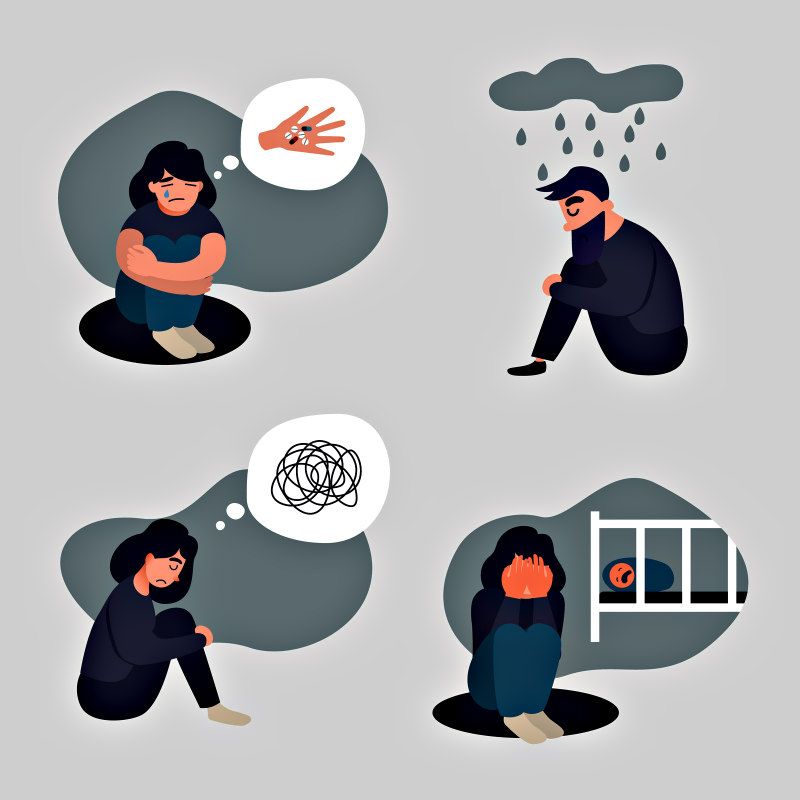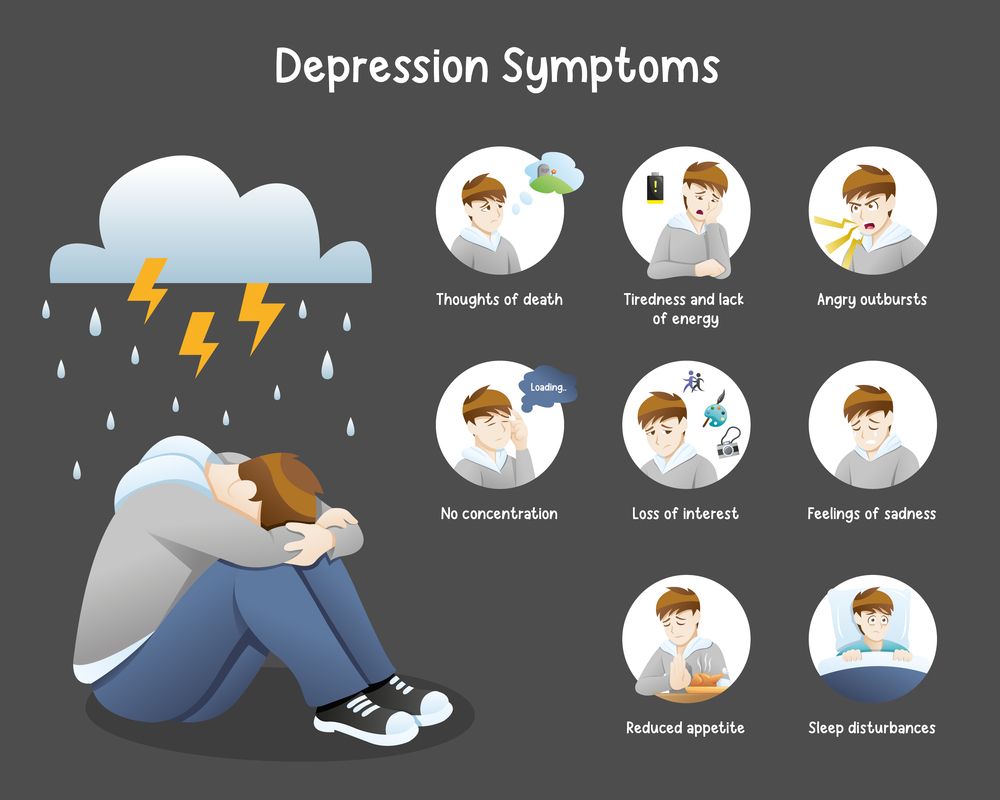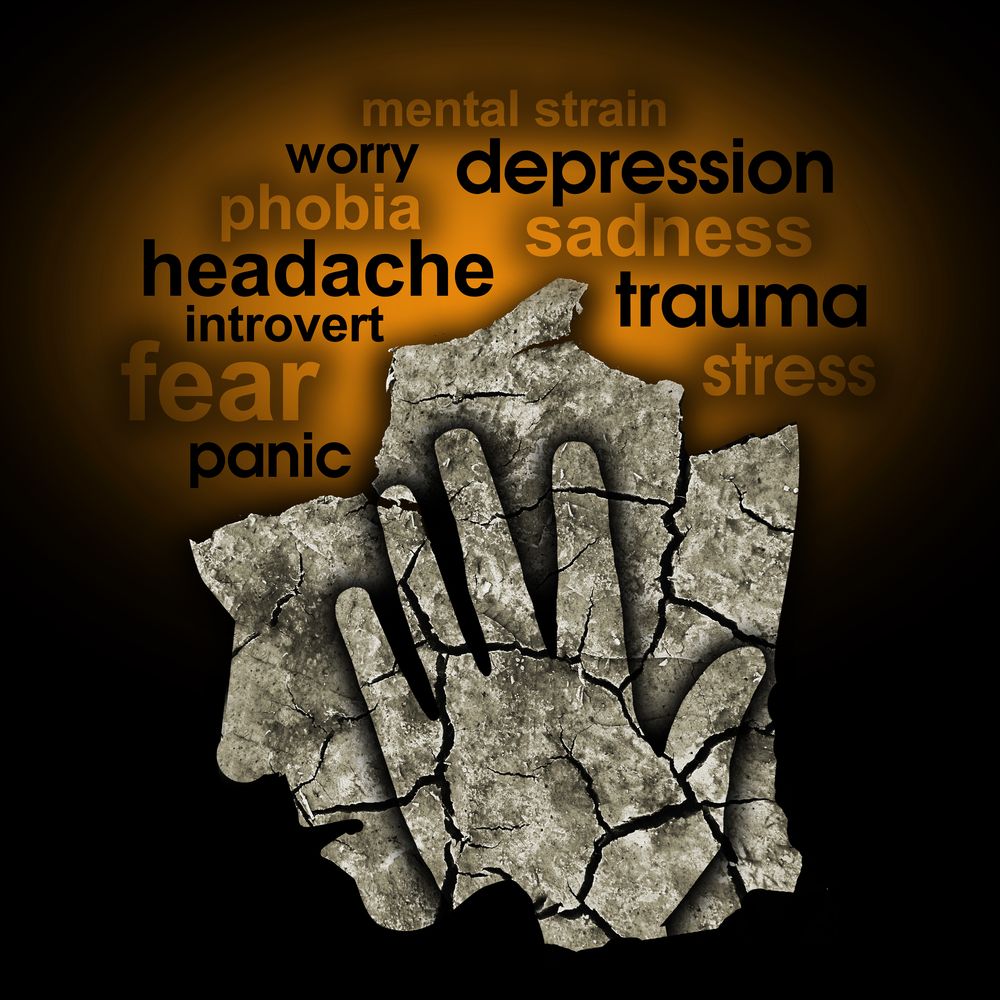Understanding depression and ending one’s own life
Lesson 1
Depression is a complex illness that affects the brain's chemistry and functioning. The World Health Organization estimates that more than 264 million people worldwide suffer from depression, with suicide being the second leading cause of death among individuals aged 15–29 years. It is a devastating reality that cannot be ignored.
Among psychiatric disorders, major depressive disorder (MDD) is the most prevalent, by affecting approximately 15–17% of the population and showing a high suicide risk rate equivalent to around 15%.
Depression and suicidal ideation are intricately linked mental health concerns that affect millions of people across the globe. Depression suicidal ideation is a distressing combination of symptoms that warrants compassionate understanding and timely intervention.
Though dark and isolating, there are paths to hope and healing for those struggling with thoughts of ending their lives.
Table of Contents
- Key Facts and Figures on Depression and Suicidal Ideation
- Prevalence of Suicide in the US.
- Prevalence of Suicide in the United Kingdom
- The Link Between Suicide and Depression
- The Role of the 988 Suicide & Crisis Lifeline
- The Impact of Major Depressive Episodes
- General Facts About Suicide and Depression
- Defining Suicide and Suicidal Thoughts
- The Preventability of Suicide
- Risk Factors for Suicide
- Statistical Facts About Suicide and Depression
- The CDC's Information Campaign on Suicide
- Suicide as a Leading Cause of Death in the US.
- Case Studies on Depression and Suicidal Ideation
- Expert Opinions and Quotes on Depression and Suicidal Ideation
- DSM-5's Take on Mental Disorder Diagnosis and Treatment
- Scientific Facts About Depression and Suicidal Ideation
- The Impact of Suicidal Thoughts on Antidepressant Treatment
- The Psychological Aspects of Suicidal Thoughts
- Involved Organizations in Suicide Prevention
- The Role of the National Suicide Prevention Lifeline
- The Contributions of the American Foundation for Suicide Prevention (AFSP)
- Significant Events in Suicide Prevention
- Conclusion
Key Takeaways
- Suicide is the 10th leading cause of death in the US, with rates rising across the country.
- Suicidal thoughts can happen to anyone and can be linked to depression.
- The 988 Suicide & Crisis Lifeline is available 24/7 in the US for those in crisis.
- More than 17 million adults experienced a major depressive episode in the previous year.
- Suicide is often preventable and has multiple risk factors.
Key Facts and Figures on Depression and Suicidal Ideation

Depression and suicidal ideation are closely intertwined with mental health issues impacting millions worldwide. Understanding key facts and statistics provides critical insight into the prevalence and gravity of these concerns.
In the US, suicide is the 10th leading cause of death, with rates rising across the country. Nearly 46,000 Americans died by suicide in 2020 according to the CDC. Suicide can often be linked to depression. Suicidal thoughts can arise in anyone, regardless of age or gender, stemming from diverse factors.
The newly launched 988 Suicide & Crisis Lifeline offers 24/7 support to those in distress.
Over 17 million US adults endured a major depressive episode in the past year.
The scope of these issues highlights the need for greater awareness, compassion, and proactive solutions.
Prevalence of Suicide in the US.
Suicide has become an increasingly urgent public health crisis in the United States. According to the CDC, suicide rates rose by 30% nationally between 2000-2018, with approximately 47,500 American lives lost to suicide in 2018 alone. Currently, suicide stands as the 10th leading cause of death in the US.
Research shows that suicide does not discriminate based on location. Both rural and urban areas have experienced rising suicide rates, though the epidemic's impact remains particularly acute in less populated regions. Some studies indicate that rural counties exhibit suicide mortality rates up to twice as high as major metropolitan areas.
Experts have linked multiple factors to increased suicide risk, including relationship problems, substance abuse, job/financial stressors, and mental health conditions like depression. Identifying those at risk and providing support through counselling, medication, or crisis intervention remains imperative. If you or a loved one are experiencing suicidal thoughts, contact the National Suicide Prevention Lifeline at 988 immediately. There is hope.
Prevalence of Suicide in the United Kingdom
Suicide has become a pressing public health issue in the United Kingdom as well. According to data from the Office for National Statistics, the suicide rate in the UK has increased significantly since the 1980s. In 2019 alone, there were 5,691 suicide registrations in England and Wales, equating to approximately 10.8 deaths per 100,000 people.
This marks the first statistically significant increase in the national suicide rate in the UK since 2013.
Research indicates that suicide does not impact all demographics equally.
Men account for around 3/4 of suicide deaths in the UK, with those aged 45-49 exhibiting the highest suicide rate. There also appear to be stark regional disparities.
For example, the North East of England shows a suicide rate nearly double that of London.
Experts have linked myriad factors to increased suicide risk, including financial stress, social isolation, grief, and mental illnesses like depression.
Ongoing research aims to enhance suicide prevention and intervention efforts across Britain.
The Link Between Suicide and Depression

The relationship between depression and suicidal risk is not fully understood. It has been suggested that genetics, stressors such as your personality and job, monetary poverty and psychiatric disorders, may play a synergistic role.
Major depressive disorder markedly elevates one's risk of suicide and is considered one of the leading causes of preventable death amongst people affected with mental disorders. Studies indicate that up to 60% of people who die by suicide suffer from major depression. The severity of depressive symptoms directly correlates with greater suicide risk as well. Those experiencing severe major depression are at a 20-fold higher risk of suicide compared to the public. (Source)
The reasons underpinning the strong depression-suicide link are multi-faceted. Depression often causes feelings of hopelessness and despair that can lead to thoughts of death or suicide. It also impairs problem-solving abilities that help generate alternative solutions during times of crisis. Physiologically, depression may reduce serotonin levels in the brain, leading to impaired impulse control and suicidal behaviours.
While the depression-suicide connection has been demonstrated, it is critical to note that suicidal ideation can arise independently as well. Regardless of the cause, suicidal thoughts should always be taken seriously.
Reaching out for professional mental health support can help overcome these troubling thoughts.
The National Suicide Prevention Lifeline at 988 provides free, 24/7 crisis assistance across the United States.
The Role of the 988 Suicide & Crisis Lifeline

Crisis Lifeline
The newly launched 988 Suicide & Crisis Lifeline offers a beacon of hope for those contemplating suicide across the United States. This easy-to-remember 3-digit phone number provides free, confidential support 24/7 to individuals experiencing suicidal crises or emotional distress.
988 is more than just a number—it represents a purposeful shift in America's mental health infrastructure. The service engages over 200 crisis centres across the country. Compassionate counsellors are specially trained in suicide intervention skills, trauma-informed care, and de-escalation techniques. Counsellors actively listen, provide support, identify resources, and work to keep the caller safe.
If necessary, 988 can also deploy emergency services to the caller's location when urgent intervention is needed. The service fills a critical gap in America's behavioural healthcare system, establishing an easily accessible support system during some of life's darkest moments.
While the 988 Lifeline serves anyone struggling with suicidal thoughts, its impact on those with depression cannot be understated. Offering judgment-free emotional support and critical resources, 988 provides a lifeline of hope when people with depression need it most. If you or a loved one are having thoughts of suicide, call or text 988 immediately.
Help is available.
You are not alone.
The Impact of Major Depressive Episodes

During severe depression, people may often think only of things that are hopeless, negative, and sad (“selective memory”). Major depressive episodes can have a profoundly detrimental impact on those struggling with depression and suicidal thoughts.
These extended periods of pervasive, unrelenting depression often severely exacerbate suicidal ideation and heighten the risk of death by suicide.
According to the National Institute of Mental Health, more than 17 million American adults experienced a major depressive episode in the past year alone.
The crippling weight of major depression can diminish the quality of life across multiple domains, including work, academics, relationships and self-care. Feelings of hopelessness, isolation, and being a burden on others frequently arise, providing fertile ground for suicidal thoughts to take root and intensify.
During major depressive episodes, people often feel utterly devoid of energy or motivation. Rudimentary self-care like getting out of bed, bathing, and preparing meals become monumental struggles.
This depletion of energy and drive exacerbates the challenges of overcoming suicidal thinking. Major depression also impairs concentration, focus and decision-making abilities - critical faculties needed to generate solutions beyond suicide.
The good news is that major depression is very treatable through psychotherapy, medication, lifestyle changes, social support and other interventions. While the exhaustion of depression can make it extremely difficult to reach out for help, doing so can literally save your life. You are not alone. If you or a loved one are experiencing a major depressive episode along with thoughts of suicide, call the 988 Suicide & Crisis Lifeline immediately. Some people, care and support is available 24/7.
General Facts About Suicide and Depression
Depression is a common mental health disorder that negatively affects how you feel, think, and act. It can lead to a variety of emotional and physical problems and can decrease your ability to function at work and home.
Suicidal thoughts and behaviours are some of the most concerning symptoms associated with depression.
Understanding the general facts about suicide and depression is a noteworthy step in recognising signs, accessing support systems, and saving lives.
Some key facts to know:
- Suicide is the act of intentionally taking one's own life. Suicidal ideation refers to persistent, frequent thoughts of suicide and can range from fleeting considerations to extensive planning.
- Suicidal feelings often stem from overwhelming emotional pain, though sometimes there may not be an identifiable cause. Talking about suicidal thoughts does not increase risk - it creates the opportunity for support.
- Suicide is often preventable through timely intervention and access to mental healthcare resources. Risk factors that may increase susceptibility include mental health disorders, substance abuse, major life stressors, access to lethal means, lack of social support, and family history.
- The newly launched 988 Suicide & Crisis Lifeline offers 24/7, confidential support to anyone experiencing a suicidal crisis or emotional distress. Calling or texting 988 connects you with compassionate counsellors trained in suicide intervention.
- Depression is one of the most substantial risk factors for suicidal ideation and behaviour. However, it's crucial to note suicidal thoughts may also arise independently of depression. All suicidal thinking warrants serious attention.
- With appropriate treatment and support, many people can overcome suicidal thinking and go on to live fulfilling lives. There is hope. Reaching out for help is often the first step.
Suicide is a complex human behaviour with multiple contributing factors. Gaining awareness of the general facts around suicide and its connection to depression helps remove stigma, identify warning signs, and open pathways to support those at risk.
If you or a loved one are experiencing suicidal thoughts, call or text 988 to speak with a crisis counsellor immediately.
Help and hope are available.
Defining Suicide and Suicidal Thoughts
Suicide is the tragic act of intentionally ending one's own life. The complexity surrounding suicidal ideation - persistent, frequent thoughts of suicide - warrants more meaningful understanding.
Simply having abstract, passive thoughts about death is not the same as active suicidal ideation. Suicidal thoughts exist on a spectrum, ranging from fleeting notions to extensive planning with intent and meaning to follow through. While passive beliefs may surface innocuously, recurring ideation demands attention.
The severity of suicidal thoughts directly correlates with risk. Mild ideation involves thinking one would be better off dead without intent to act. As ideation intensifies, planning may begin, signalling a high risk for suicidal behaviour. Severe ideation paired with purpose and planning requires urgent intervention.
It is a myth that discussing suicide increases risk - speaking up saves lives. Voicing thoughts openly creates an opportunity for support. If you or a loved one are experiencing suicidal ideation, call the 988 Suicide & Crisis Lifeline immediately. There is hope.
Statistical Facts About Suicide and Depression
According to the Centres for Disease Control and Prevention (CDC), suicide is a growing public health concern and one of the leading causes of death in the United States.
Here are some key statistical facts about the relationship between suicide and depression:
- In 2020, approximately 45,979 people died by suicide in the United States, making suicide the 10th leading cause of death overall. It is the 2nd leading cause of death for people ages 10-34. (Source)
- There is a strong link between depression and suicide - depression is estimated to be present in 50-75% of all suicide deaths. People with mood disorders like depression are 20 times more likely to die by suicide than the general population. (Source)
- Suicide rates increased 33% between 1999 and 2019 in the United States. The increase was seen across age groups, genders, races/ethnicities, and geographic regions. (Source)
- Firearms account for approximately 50% of all suicide deaths in the US, making access to guns a significant risk factor. (Source)
- While more men than women die by suicide, women are more likely to have suicidal thoughts. In 2020, 5% of men and 9% of women reported seriously considering suicide. (Source)
- Suicide does not discriminate by location - from 1999-2016, suicide rates rose over 30% in both rural and urban areas in the US. Rural counties had the highest rates overall. (Source)
The concerning rise in suicide rates highlights the need for greater awareness, prevention efforts, and access to mental health resources. If you or someone you know is struggling with suicidal thoughts, call the National Suicide Prevention Lifeline at 988 for free 24/7 support.
Scientific Facts About Depression and Suicidal Ideation
Depression and suicidal thinking are intricately connected in a complex interplay of psychological, biological, and social factors. Understanding key scientific facts provides critical insight.
The Psychological Aspects of Suicidal Thoughts
From a psychological perspective, suicidal ideation often stems from overwhelming emotional pain or perceived burdensomeness - the sense that one's existence is a burden on loved ones. These excruciating emotions create a desperate longing for escape that can override self-preservation instincts.
Cognitive distortions also contribute, fuelling irrational beliefs that suicide is the only solution to life's struggles. Impaired problem-solving abilities and fatalistic thinking prevent envisioning hopeful alternatives.
Psychological therapy helps identify and reframe these distorted thought patterns.
Building resilience through counselling also equips people to endure emotional pain without succumbing to hopelessness.
Boosting self-esteem and cultivating purpose and meaning in life further counteract suicidal ideation's psychological underpinnings. There are paths beyond the darkness.
The Preventability of Suicide

Suicide is often seen as an inevitable tragedy, but the truth is that many suicides can be prevented with the right interventions and support systems. While suicidal ideation is complex, and there are no blanket solutions, research consistently shows that suicide is far from an unstoppable fate for those at risk.
A key aspect of prevention is identifying those most susceptible to suicide.
While risk factors like mental illness, substance abuse, trauma, isolation, and access to lethal means are essential, experts caution we cannot rely on these factors alone.
Preventing suicide requires looking at the whole person.
Their unique circumstances, resources, coping skills, and support systems shape their resilience.
Interventions like counselling, public awareness campaigns, crisis hotlines, medication, and reducing access to lethal means have proven impacts.
Bolstering social connectedness is also vital - isolation drastically increases risk.
While more research is still needed, the evidence clearly shows suicide prevention is possible through timely, compassionate intervention. If you or a loved one are experiencing suicidal thoughts, call or text 988, the National Suicide Prevention Lifeline, immediately. Some people want to help.
Risk Factors for Suicide
Understanding the factors that increase suicide risk provides critical insight for prevention and intervention efforts. While the path to suicide is complex and unique for each individual, decades of research have identified key risk factors to be aware of.
Mental Disorders
Mental illnesses, particularly mood disorders like depression and bipolar disorder, significantly increase suicide risk. 90% of people who die by suicide have a diagnosable mental condition. Feelings of hopelessness and despair can lead to suicidal thoughts.
Substance Abuse
Drug and alcohol addiction doubles one's risk for suicidal ideation and behaviour. Substances reduce inhibitions and impair judgment, making a person more likely to act on suicidal thoughts. Getting treatment for substance abuse issues is imperative.
Access to Lethal Means
Easy access to guns, medications, or other lethal means escalates risk, especially during times of crisis. Securing or removing potentially deadly objects saves lives during periods of heightened vulnerability.
Trauma and Abuse
Those who endure traumatic life events or abuse have a higher susceptibility to suicidal thinking and actions. Trauma counselling helps healthily process painful experiences.
Prolonged Stress
Overwhelming stressors like financial ruin, relationship conflicts, health issues, or unemployment can become unbearable. Building resilience and adopting healthy coping mechanisms helps endure times of prolonged duress.
Isolation and Loneliness
Lack of social connection and support exacerbates risk, while close relationships and community integration foster hope and meaning. Regular social interaction and outreach to those isolated help prevent suicide.
Previous Suicide Attempts
A prior suicide attempt is the strongest predictor of dying by suicide. Continuity of care after an attempt is critical, along with limiting access to lethal means during recovery.
While risk factors provide guidance, each situation is unique. Compassionate evaluation of a person's complete circumstances helps determine the level of risk and appropriate interventions. If you or a loved one are experiencing suicidal thoughts, call or text 988 immediately to speak with a crisis counsellor. Help is available 24/7.
The CDC's Information Campaign on Suicide
The United States Centres for Disease Control and Prevention (CDC) has launched a significant national public health campaign to educate Americans about suicide risk factors beyond mental illness alone.
While mental disorders like depression are strongly correlated with suicidal ideation, the CDC's research shows myriad factors contribute to suicide susceptibility. Their campaign aims to highlight these diverse risks to enhance prevention efforts.
The CDC's public awareness initiative strives to reduce the stigma surrounding suicide and spur open, compassionate dialogue. Their research reveals over half of Americans who died by suicide did not have a known mental health condition.
Relationship problems, substance abuse, financial stress, chronic health issues, and traumatic experiences are among the range of risks that can increase susceptibility.
Experts praise the CDC's campaign for taking a more holistic, personalised approach to suicide prevention. Simply screening for mental illness fails to capture the complete picture of an individual's life circumstances and risk profile. The campaign aims to educate community leaders, healthcare providers and the public about properly assessing overall risk and protective factors. It also connects people with critical resources like the 988 Suicide & Crisis Lifeline.
While the mental health community agrees addressing psychiatric disorders is crucial, the CDC notes we must also look beyond diagnoses alone to implement timely interventions. Their information campaign brings us one step closer to more comprehensive, compassionate suicide prevention.
Suicide is a Leading Cause of Death in the US.
Suicide has become one of the most pressing public health crises in the United States. According to the latest data from the Centres for Disease Control and Prevention (CDC), suicide was the 10th leading cause of death overall in the US in 2020. An alarming 45,979 American lives were lost to suicide that year alone.
After decades of steady increase, the US suicide rate escalated by 30% nationally between 2000-2018. Suicide rates have risen across the board, with few segments of the American population left untouched by this growing epidemic.
While numerous factors contribute to individual suicide susceptibility, the sheer scale of the problem highlights the urgent need for greater awareness, compassionate dialogue, and access to mental health resources.
Specific demographics have proven especially vulnerable to suicide's sobering toll. Middle-aged adults exhibit the highest suicide rates, with those aged 45-54 facing the most significant risk. However, suicide has tragically become the 2nd leading cause of death for young people aged 10-24 in America - a concerning statistic signalling deep societal issues.
From a geographic standpoint, rural regions report disproportionately high suicide rates compared to urban areas, though urban communities are not immune to the growing problem. Effective prevention requires understanding both underlying regional influences and broader sociocultural factors that have contributed to the rise in suicide mortality across all of America.
While the path to suicide is complex and unique for each individual, this public health crisis is often preventable through timely community response and improved access to mental healthcare resources. If you or a loved one are having thoughts of suicide, call or text the National Suicide Prevention Lifeline at 988 immediately. There is hope.
Involved Organisations in Suicide Prevention
The Role of the National Suicide Prevention Lifeline
The National Suicide Prevention Lifeline (NSPL) offers a critical lifeline for people experiencing suicidal crisis. This national network of over 200 local crisis centres provides free, confidential emotional support 24/7 to distressed individuals. The service can be reached by calling 988 in the US.
Initially launched in 2005 as the National Suicide Prevention Lifeline, this vital resource was accessible by dialling 1-800-273-TALK (8255). However, in July 2022, mental health advocates celebrated expanded access with the rollout of the new, easy-to-remember 988 dialling code.
The 988 Suicide & Crisis Lifeline builds on the NSPL's foundation while aiming to further strengthen and streamline suicide prevention services in America. Early data suggests 988 is already saving lives - the number of contacts has substantially increased since its launch. The service has received over 2 million calls annually in recent years.
When people call or text 988, they are immediately connected with trained, compassionate crisis counsellors who listen without judgement, offer support, and provide resources. Counsellors are specially trained in suicide intervention skills, trauma-informed care, and de-escalation techniques.
If necessary, 988 can also deploy emergency services to the caller's location when there is imminent danger. However, the focus is first on resolving the crisis through caring connection and conversation. Studies show that callers feel significantly less suicidal and more hopeful after speaking with counsellors.
The 988 Lifeline fills a vital gap in America's mental healthcare infrastructure, establishing an easily accessible network for suicide prevention. It offers a beacon of hope for those contemplating suicide and provides meaningful resources for friends and family trying to help loved ones in crisis. You are not alone.
The Contributions of the American Foundation for Suicide Prevention (AFSP)
The American Foundation for Suicide Prevention (AFSP) has made invaluable contributions to suicide prevention efforts in the United States. As the nation's largest suicide prevention organisation, AFSP has been instrumental in advancing research, education, advocacy, and support for those impacted by suicide.
One of AFSP's most significant initiatives is advocating for state and federal policies aimed at preventing suicides. They led efforts to enact the National Suicide Hotline Designation Act, which helped establish 988 as the new three-digit dialling code for the National Suicide Prevention Lifeline. This provides streamlined access to vital crisis services.
AFSP has also championed legislation to limit access to lethal means among those at risk. They encourage voluntary firearm transfers and medication disposal programs to reduce access during times of crisis. Restricting access to guns, drugs, and other lethal means saves lives.
The organisation funds scientific research on suicide risk factors, prevention, and treatment. AFSP has supported studies examining the neurobiology of suicide, psychological factors, and the efficacy of prevention programs. Translating research into action is pivotal.
Through public education campaigns, AFSP strives to increase awareness, reduce stigma, and inspire hope. Their Interactive Screening Program provides anonymous mental health screening to connect people with resources. Proactive outreach makes a difference.
AFSP also offers critical prevention support services for suicide loss survivors. They provide healing resources like support groups, counselling, and guidance to those grieving tragic loss. Ensuring continuity of care is vital.
With a comprehensive, evidence-based approach focused on research, education, advocacy and support, the American Foundation for Suicide Prevention leads life-saving efforts to prevent suicides and help heal those affected by suicide's devastating toll. If you or a loved one are struggling with suicidal thoughts, call the 988 Lifeline for free, confidential support 24/7.
You are not alone.
Significant Events in Suicide Prevention
Suicide prevention efforts have evolved considerably over the past century, with several key events helping advance awareness, intervention, and support. Examining this history illuminates critical turning points.
2001 - First National Strategy for Suicide Prevention
In 2001, the first-ever National Strategy for Suicide Prevention was posted under the leadership of Surgeon General David Satcher. This watershed document outlined a comprehensive national agenda to reduce the suicide toll through coordinated public health efforts. The strategy identified key goals across awareness, intervention, methodology, and treatment domains and catalysed progress.
2005 - Launch of National Suicide Prevention Lifeline
The launch of the National Suicide Prevention Lifeline in 2005 marked a pivotal advancement in crisis intervention. This free, confidential hotline provides 24/7 support to those in emotional distress or suicidal crisis. It can be reached by calling 1-800-273-TALK—the easily remembered number connected millions to compassionate crisis counsellors trained in suicide intervention.
2008 - Passage of Garrett Lee Smith Act
The passage of the Garrett Lee Smith Memorial Act in 2004 and its reauthorisation in 2008 demonstrated the US government's growing prioritisation of youth suicide prevention. This legislation funded critical suicide intervention, awareness, and training programs focused on youth and young adults - demographics exhibiting escalating suicide rates.
2022 - Launch of 988 Suicide and Crisis Lifeline
In July 2022, the existing National Suicide Prevention Lifeline transitioned to the new 988 dialling code. This simple 3-digit access builds on Lifeline's foundation while aiming to further strengthen and streamline suicide prevention services in America. Early data shows that 988 is already saving lives.
While more progress is still needed, these events reflect pivotal milestones in the continued evolution of suicide prevention in the US. If you or a loved one are struggling with suicidal thoughts, call or text 988 to speak with a compassionate crisis counsellor 24/7.
Case Studies on Depression and Suicidal Ideation

Case studies provide real-world examples that illuminate the complex interplay between depression and suicidal ideation—examining individual experiences in-depth fosters greater understanding and compassion.
The Case of John
John was a 63-year-old married entrepreneur with no prior mental health history who developed severe depression after a series of financial setbacks. Over six months, he became increasingly withdrawn and sad. He began thinking frequently that his family would be better off without him.
John started making statements about ending his life, but initially had no specific plan. As his depression deepened, however, his suicidal ideation became more intense and detailed. He began stockpiling prescription medications, indicating he now had the means to act. At this stage, John's risk of suicidal behaviour was extremely high.
Through compassionate evaluation, clinicians recognised John's crisis point. With intensive treatment, including therapy and medication, John's condition began improving over several months.
Ongoing support from family strengthened his recovery, allowing him to overcome the darkest period of his life.
The Case of Sarah
Sarah was a 17-year-old high school junior battling severe depression and anxiety. Over three years, she withdrew from friends and activities she once enjoyed. Her grades declined sharply as her focus and motivation evaporated.
Feelings of inner pain, hopelessness and self-loathing intensified, leading Sarah to start self-harming through cutting. Alienated from peers and terrified of disappointing her parents, Sarah's suicidal thoughts escalated. She began researching lethal doses of certain medications.
A teacher noticed the cuts on Sarah's arms and, recognising the crisis, intervened immediately. Connecting Sarah with counselling, medication, and a support group proved life-saving. Over time, her mood and outlook improved dramatically. She learned healthy coping strategies to overcome the darkest thoughts.
Expert Opinions and Quotes on Depression and Suicidal Ideation
Understanding perspectives from experts in mental health and suicide prevention fosters greater insight into depression and suicidal thinking. Examining critical opinions and quotes provides a human lens through which to view these intricate issues.
DSM-5's Take on Mental Disorder Diagnosis and Treatment
The Diagnostic and Statistical Manual of Mental Disorders (DSM-5), considered the authoritative guide to psychiatric diagnoses, offers a critical perspective:
"Diagnosis of a mental disorder should have clinical utility", but "the diagnosis of a mental disorder is not equivalent to a need for treatment. Need for treatment is a complex clinical decision that takes into consideration symptom severity, symptom salience (e.g., the presence of suicidal ideation)..."
This viewpoint thoughtfully delineates between diagnosis and the necessity of treatment, while emphasising that suicidal thinking warrants urgent clinical attention, given the risk of harm.
Esquirol on the Relationship Between Suicide and Mental Illness
French psychiatrist Jean-Étienne Dominique Esquirol, who conducted extensive research on suicide in the 19th century, stated:
"Suicide presents all the characteristics of insanity, of which it is but a symptom."
Esquirol's assertion spotlights the intricate, inextricable link between suicide and mental disorders like depression. His words thoughtfully frame suicide as a possible manifestation of an underlying psychiatric illness requiring compassionate treatment.
Summary Perspective
These experts provide nuanced perspectives on suicide's connection to mental health issues. Their insights advocate for compassionate, holistic treatment while emphasising that suicidal ideation signifies high risk, necessitating urgent care. For anyone struggling with suicidal thoughts, the 988 Lifeline offers 24/7 support and resources. You are not alone.
DSM-5's Take on Mental Disorder Diagnosis and Treatment
The Diagnostic and Statistical Manual of Mental Disorders (DSM-5) provides the standard criteria for diagnosing mental health conditions in the United States. Published by the American Psychiatric Association (APA), the DSM aims to establish consistent, evidence-based diagnostic guidelines to inform effective treatment. The manual's perspective on diagnosing disorders like depression sheds light on the appropriate clinical response when suicidal ideation is present.
According to the DSM-5, meeting diagnostic criteria for a disorder alone is insufficient to warrant treatment intervention. The manual states: "Diagnosis of a mental disorder should have clinical utility" but "the diagnosis of a mental disorder is not equivalent to a need for treatment." Determining appropriate treatment requires a nuanced evaluation of symptom severity, impacts on functioning, and risk factors like suicidal thinking.
The DSM-5 pointedly asserts that assessing suicide risk is an essential consideration when evaluating the necessity for treatment.
The presence of suicidal thoughts or behaviours obviously signifies heightened clinical concern, given the possibility of self-harm. Thoughtful risk assessment and triage are required, which may involve counselling, medication, hospitalisation, or other interventions aimed at ensuring the patient's safety.
In summary, the DSM-5 maintains that merely meeting diagnostic criteria should not automatically necessitate treatment. However, the manual underscores that suicidal ideation changes the clinical calculus, indicating a high risk that warrants an urgent treatment response. By thoughtfully delineating diagnosis from treatment needs, the DSM provides critical guidance to clinicians serving those with depression and suicidal thoughts.
The Impact of Suicidal Thoughts on Antidepressant Treatment

Studies suggest suicidal ideation may limit antidepressants' effectiveness in those with major depression, indicating an intricate neurochemical relationship between suicidality and treatment response.
The reasons are complex and require more research, but possible explanations include:
- Suicidal thoughts may reflect more severe, resistant depression subtypes.
- They may alter neurotransmitter systems like serotonin, impacting drugs' mechanisms.
- Ideation itself may directly oppose antidepressants' effects.
However, evidence also indicates medication and therapy can still help overcome suicidal thinking in many people. A personalised, multi-faceted treatment approach is fundamental.
While more studies are needed, scientific evidence reveals suicide's close, multi-faceted neurobiology links with mood disorders. A compassionate, integrated treatment strategy explicitly focused on alleviating suicidal ideation offers hope. If you or a loved one are struggling with suicidal thoughts, call the 988 Lifeline - help is available 24/7.
The Impact of Suicidal Thoughts on Antidepressant Treatment
When an individual is battling major depressive disorder, introducing medication repeatedly provides a vital lifeline. However, the presence of suicidal thoughts may limit antidepressants' effectiveness for some patients. While more research is still needed, studies suggest a complex interplay between suicidality and treatment response.
Several theories attempt to explain this phenomenon. First, suicidal ideation may indicate particularly severe or treatment-resistant depression subtypes. Individuals grappling with frequent suicidal thoughts tend to describe their depressive symptoms as extraordinarily intense and unremitting. This sheer depth of despair can overwhelm the medication's effects.
Additionally, the emergence of suicidal thinking may alter underlying neurotransmitter systems like serotonin, which antidepressants target. The suicidal mind can develop its own stubborn neurobiology resistant to first-line interventions. Patients with high suicide risk also frequently possess co-occurring issues like anxiety disorders or substance abuse, which complicate treatment.
Finally, some research indicates that suicidal ideation itself may directly oppose antidepressants' mechanisms, rendering certain drugs ineffective. The reasons are complex and multifactorial. However, the takeaway is that medication alone is often insufficient for those with major depression experiencing frequent, intense suicidal thoughts.
Integrated treatment incorporating psychotherapy, social support, and specialised suicidality interventions alongside antidepressants provides the best chance of overcoming despair. With compassion and perseverance, we can help turn the tide against even the most stubborn cases of suicidal depression. The newly launched 988 Suicide & Crisis Lifeline is available 24/7 for anyone needing emotional support during their darkest moments.
The Psychological Aspects of Suicidal Thoughts
Suicidal thinking arises from overwhelming emotional anguish. When pain exceeds one's perceived ability to cope, suicidal ideation can emerge as an envisioned escape. The sheer despair of major depression often fosters this hopeless mindset.
Psychologically, those experiencing frequent suicidal thoughts tend to share common thought patterns.
Cognitive distortions fuel irrational beliefs that suicide is the only solution. Impaired problem-solving prevents generating alternatives. Fatalistic thinking eclipses hope. (Source)
Building resilience through counselling equips individuals to withstand emotional turmoil. It boosts self-esteem and cultivates meaning, counter hopelessness. Reframing irrational beliefs helps restore a realistic perspective. Social support provides connections missing in isolation.
While incredibly difficult, reaching out for professional mental health support is often the first step toward healing—organisations like the 988 Suicide & Crisis Lifeline offer 24/7 assistance to those enduring psychological anguish.
You are not alone.
The National Suicide Prevention Lifeline (NSPL) plays a vital role in suicide prevention and crisis intervention in the United States. Operated by the nonprofit Vibrant Emotional Health, NSPL provides free, 24/7 emotional support to individuals in suicidal crisis or emotional distress.
People can call 1-800-273-8255 to speak with a trained crisis counsellor. Counsellors actively listen, assess risk, deliver support, and connect callers with local resources. The Lifeline receives over 2 million calls annually. Studies show that callers feel lower distress and suicidality after speaking with counsellors.
In July 2022, NSPL launched the new 988 Suicide & Crisis Lifeline - a simple 3-digit dialling code providing streamlined access to crisis services. 988 builds on NSPL's decades of experience operating the national suicide prevention hotline. Early data indicates that 988 is saving lives - the easier-to-remember number has led to increased contacts.
NSPL strives to reduce the stigma around mental health issues. Speaking openly about emotional pain and suicidal thoughts is often the first step toward healing. The Lifeline's compassionate support services provide a lifeline of hope to millions in crisis each year.
Conclusion
Depression and suicidal ideation are intricately connected, multilayered human experiences that defy oversimplification. While this guide explored key statistics, risk factors, and expert insights, fully grasping the anguish of hopelessness proves difficult for those unaffected. We each possess a fundamental duty to meet such struggles with open minds, open hearts, and open arms.
The path ahead remains long. Yet, the emergence of lifelines like the 988 Lifeline and growing societal openness to these issues inspire hope. While the pain of depression and suicidality inflict deep wounds, we must not lose faith in humanity's capacity for resilience and healing. For those enduring the darkest of nights, take heart - the sun also rises. When the will to live falters, reach out your hand. Kind souls will grasp it.
Understanding the relationship between depression and suicidal ideation is crucial in order to provide appropriate support and intervention for those in need. It is vital to recognize the warning signs and risk factors associated with suicidal ideation in individuals with depression, as well as the importance of seeking professional help. In this article, we will explore the connection between depression and suicidal ideation, and discuss ways to effectively address this serious issue.
.
